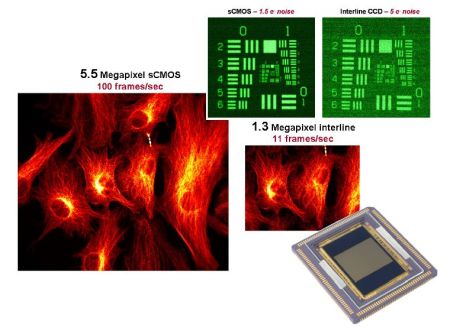At Laser 2009 – World of Photonics in Munich, Germany, the fastest CMOS ever was introduced. The Scientific CMOS chip enables image acquisitions at 100 frames per second.
Common Imaging Detectors
CCDs and EMCCDs
For CCDs it is feasible to achieve less than 3 electrons RMS readout noise, but due to the serial readout nature of conventional CCDs, this performance comes at the expense of frame rate. Conversely, when CCDs are pushed to faster frame rates, resolution and field of view are sacrificed (i.e. fewer pixels per frame to read out) or read noise and dynamic range suffer. These devices are capable of reading out at 20Mpixel/s per output port with a respectable read noise of only 5 to 6 electrons RMS. At this readout speed a single port 1.3 megapixel sensor can achieve 11 frames/s. The Electron Multiplying CCD (EMCCD) was introduced into the market in 2000 and represented a significant leap forward in addressing the mutual exclusivity of speed and noise. EMCCD cameras employ an on-chip amplification mechanism called ‘Impact Ionization’ that multiplies the photoelectrons that are generated in the silicon.
CMOS Imaging Sensors (CIS)
CIS are similar to CCD sensors, in so far as they are semiconductor devices with photosensitive areas in each pixel that convert incident photons into electrons. ‘Traditional’ CIS performance has generally been worse than CCDs and their acceptance into scientific markets has been limited due to a reputation of unacceptably high read noise and dark current, lower fill factors, and greater non-uniformity.
Hybrid CCD/CMOS Image Sensors
A hybrid focal plane array is comprised of CMOS Readout Integrated Circuits (ROICs) that are bump bonded to a CCD imaging substrate. By applying a column-parallel readout architecture, the speed versus noise limitations of a conventional CCD can be overcome.
The New Scientific CMOS
Scientific CMOS (sCMOS) can be considered unique in its ability to simultaneously deliver on many key performance parameters, overcoming the ‘mutual exclusivity’ that was earlier discussed in relation to current scientific imaging technology standards, and eradicating the performance drawbacks that have traditionally been associated with conventional CIS. The 5.5 megapixel sensor offers a large field of view and high resolution, without compromising read noise or frame rate. The sensor is capable of achieving 100 full frames/s with a read noise < 3 electrons RMS.
Performance Highlights of the First sCMOS Technology Sensor Include:
– Sensor format 5.5 megapixels 2560 (h) x 2160 (v)Read noise < 2 e- rms @ 30 frames/s; < 3 e- rms @ 100 frames/s
– Maximum frame rate 100 frames/sPixel size 6.5 μm
– Dynamic range 16,000:1 @ 30 frames/s
– QEmax 60%
– Read out modes (user selectable) Rolling and Global Shutter
www.scmos.com/downloads

Scientific CMOS Technology-A High-Performance Imaging Breakthrough




 Veröffentlicht von aszerdi
Veröffentlicht von aszerdi 